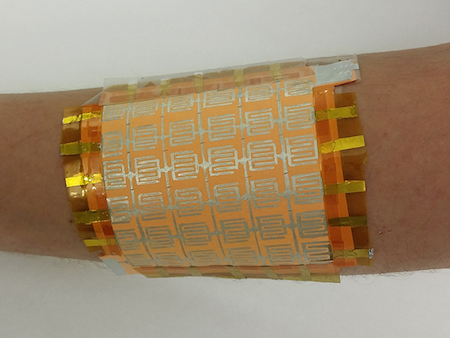Science Fiction
Dictionary
A B C D E F G H I J K L M N O P Q R S T U V W X Y Z
Cheap Electronic Skin For Robots!

Inexpensive robots need inexpensive skin!

(KAUST paper electronic skin)
The artificial skin may represent the first single sensing platform capable of simultaneously measuring pressure, touch, proximity, temperature, humidity, flow, and pH levels. Previously, researchers have tried using exotic materials such as carbon nanotubes or silver nanoparticles to create sensors capable of measuring just a few of those things. By comparison, the team at King Abdullah University of Science and Technology (KAUST) in Saudi Arabia used common off-the-shelf materials such as paper sticky notes, sponges, napkins and aluminum foil. Total material cost for a paper skin patch 6.5 centimeters on each side came to just $1.67.”Its impact is beyond low cost: simplicity,” says Muhammad Mustafa Hussain, an electrical engineer at KAUST. “My vision is to make electronics simple to understand and easy to assemble so that ordinary people can participate in innovation.”
The paper skin’s low cost and wide array of capabilities could have a huge impact on many technologies. Flexible and wearable electronics for monitoring human health and fitness could become both cheaper and more widely available. New human-computer interfaces—similar to today’s motion-sensing or touchpad devices—could emerge based on the paper skin’s ability to sense pressure, touch, heat, and motion. The paper skin could also become a cheap sensor for monitoring food quality or outdoor environments.
The earliest reference to the idea of pressure-sensitive artificial skin in science fiction, as far as I know, is the Chemelectric Afferent Nerve-Analogues from This Immortal, a terrific 1966 novel by Roger Zelazny:
A worthy opponent was the golem. Hasan had it programmed at twice the statistically-averaged strength of a man and had its reflex-time upped by fifty percent. Its memory contained hundreds of wrestling holds and its governor theoretically prevented it from killing or maiming its opponent - all through a series of chemelectric afferent nerve-analogues, which permitted it to gauge to an ounce the amount of pressure necessary to snap a bone or tear a tendon. Rolem was about five feet, six inches in height and weighed around two hundred fifty pounds...
Via IEEE Spectrum.
Scroll down for more stories in the same category. (Story submitted 2/17/2016)
Follow this kind of news @Technovelgy.| Email | RSS | Blog It | Stumble | del.icio.us | Digg | Reddit |
Would
you like to contribute a story tip?
It's easy:
Get the URL of the story, and the related sf author, and add
it here.
Comment/Join discussion ( 0 )
Related News Stories - (" Robotics ")
Proof Of Robothood - Not A Person
'Who are you people? - Show 'em.' - James Cameron (1984).
Dancing Robots Taught Dance Moves
'A clockwork figure would be the thing for you...' Jerome K. Jerome, 1893.
Factory Humanoid Robots Built By Humanoid Robots
'...haven't you a section of the factory where only robot labor is employed?' - Isaac Asimov (1940).
Mornine Sales Robot
'Robot-salesmen were everywhere, gesturing...' - Philip K Dick, 1954.
Technovelgy (that's tech-novel-gee!) is devoted to the creative science inventions and ideas of sf authors. Look for the Invention Category that interests you, the Glossary, the Invention Timeline, or see what's New.
Science Fiction
Timeline
1600-1899
1900-1939
1940's 1950's
1960's 1970's
1980's 1990's
2000's 2010's
Current News
Proof Of Robothood - Not A Person
'Who are you people? - Show 'em.'
Dancing Robots Taught Dance Moves
'A clockwork figure would be the thing for you...'
Indonesian Clans Battle
'The observation vehicle was of that peculiar variety used in conveying a large number of people across rough terrain.'
The 'Last Mile' In China Crowded With Delivery Robots
Yes, it's a delivery robot. On wheels.
Tornyol Microdrone Kills Mosquitoes
'The real border was defended by... a swarm of quasi-independent aerostats.'
PLATO Spacecraft, Hunter Of Habitable Planets, Now Ready
'I ... set my automatic astronomical instruments to searching for a habitable planet.'
Factory Humanoid Robots Built By Humanoid Robots
'...haven't you a section of the factory where only robot labor is employed?'
iPhone Air Fulfils Jobs' Promise From 2007 - A Giant Screen!
'... oblongs were all over the floor and surfaces.'
ChatGPT Now Participates in Group Chats
'...the city was their laboratory in human psychology.'
iPhone Pocket All Sold Out!
'A long, strong, slender net...'
Did The Yautja Have These First?
What a marvel of ingenuity the little device was!
Jetson ONE Air Races Begin, Can Air Polo Be Far Behind?
'If you're one of those rarities who haven't attended a rocket-polo "carnage", let me tell you it's a colorful affair.'
Will Space Stations Have Large Interior Spaces Again?
'They filed clumsily into the battleroom, like children in a swimming pool for the first time, clinging to the handholds along the side.'
Mornine Sales Robot
'Robot-salesmen were everywhere, gesturing...'
Bipedal Robot Floats Gently While Walking
'a walking balloon proceeded with long strides of its aluminum legs...'
Musk Idea Of Cars Talking To Each Other Predicted 70 Years Ago
'My cars talk to one another.'
